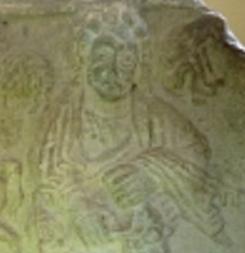St Andrews Sarcophagus facts for kids
The Saint Andrews Sarcophagus is a very old stone coffin from the Picts, an ancient group of people who lived in Scotland. This special coffin was made in the late 700s. It was found in pieces starting in 1833 near St Andrews Cathedral in St Andrews, Scotland. All the parts were finally put back together in 1922. Today, you can see the sarcophagus at the Cathedral museum in St Andrews, very close to where it was first discovered.
Contents
What is the St Andrews Sarcophagus?
A sarcophagus is a stone coffin, usually used for important people. The St Andrews Sarcophagus is famous because of its detailed carvings and its age. It tells us a lot about the Picts and their art.
What Does It Look Like?
When it was first made, the sarcophagus had two long side panels, two end panels, four corner pieces, and a lid on top. Sadly, the lid is completely missing. Most of one side and one end panel are also gone, along with a corner piece. So, what we see today is mostly shaped like an "L".
The sarcophagus is about 177 centimeters (about 5.8 feet) long, 90 centimeters (about 3 feet) wide, and 70 centimeters (about 2.3 feet) tall. It is made from local sandstone.
The Carved Panels
The side panel that is still mostly complete shows some amazing carvings. From right to left, you can see:
- A person bravely breaking open the jaws of a lion.
- A hunter on horseback, holding a sword high, ready to strike a lion that is jumping.
- Another hunter on foot, carrying a spear, with a hunting dog helping him. He is about to attack a wolf.
It's not certain if the first two figures are the same person, but old drawings from the 1800s show them as if they are. The surviving end panel is simpler. It has a cross with four small carved sections around its arms. The pieces of the missing end panel are similar but not exactly the same.
How Was It Found?
The sarcophagus was found inside the grounds of St Andrews Cathedral, close to the St Regulus Chapel. The Cathedral itself was built in the 1100s. It was used for many years until 1559, when it was left in ruins during a time called the Reformation. Much of its stone was later used to build other structures in the town of St Andrews.
In 1833, workers were digging a grave when they found the large pieces of the sarcophagus. They were buried about 6 to 8 feet deep. Over the years, copies of the pieces were made, but the original parts were not put back together until 1922.
Who Was Buried Here?
Historians and experts have different ideas about who might have been buried in the St Andrews Sarcophagus. Many believe it was made for a Pictish King named Óengus, also known as Onuist. He was a Christian king who died in 761.
However, it's not completely clear if Óengus was actually buried in it. Some think it might have been used for his predecessor, another king named Nechtan mac Der Ilei, or perhaps someone important who lived even later. The mystery of who rests inside makes the sarcophagus even more fascinating!



